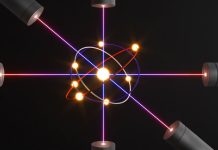A research team led by Helmholtz-Zentrum Dresden-Rossendorf (HZDR), in collaboration with the European XFEL, has successfully simulated extreme conditions similar to the ones found inside stars and planets using a smaller, more accessible laser technology
This breakthrough is important as it opens new doors for high-pressure and high-temperature research, making such studies more feasible without relying on rare, powerful lasers like those at the National Ignition Facility (NIF) in California.
The new method involves firing an ultra-short laser pulse at a copper wire 25 micrometers thick. This pulse generates a local shock wave, with high-energy electrons racing along the wire’s surface. The shock waves collide at the centre of the wire, creating a momentary state of extreme pressure and heat that simulates conditions like those inside planets or stars.
Observing shock waves with precision
The research was made possible using the ultra-precise X-ray flashes from the European XFEL, which allowed the team to capture detailed “X-ray films” of the event. This combination of short-pulse laser and X-ray laser enabled the observation of unprecedented details, offering a clearer understanding of the process as shock waves pass through the wire and create extreme densities and temperatures.
The team successfully achieved a pressure of around 800 megabars, which is 800 million times atmospheric pressure and about 200 times the pressure found in Earth’s core. Temperatures reached approximately 100,000 degrees Celsius, resembling conditions in the corona of a white dwarf star. These findings are significant in replicating astronomical conditions in a controlled environment.
Impact on astrophysics and planetary science
The research holds potential for astrophysics, particularly in understanding the conditions inside large gas planets like Jupiter or distant exoplanets. The ability to recreate extreme environments in the lab allows scientists to explore the behaviour of materials under conditions similar to those found in distant celestial bodies.
This new method could play a key role in advancing nuclear fusion research. By providing a way to observe what happens inside fuel capsules when hit by laser pulses, the experiment could help refine the process of fusion energy generation, where more energy is produced than consumed. This method may significantly help the development of future fusion power plants.
The team plans to extend the experiment to wires made of different materials, including iron and plastic, which contain elements commonly found in stars.
“With our method, we could observe in detail what happens inside the capsule when it is hit by the laser pulses,” says Cowan, describing future experiments. “We expect that this can have a huge impact on basic research in this area.”











